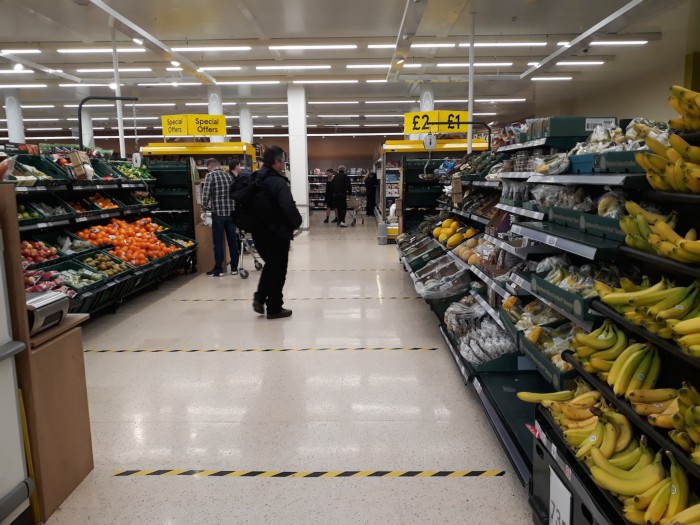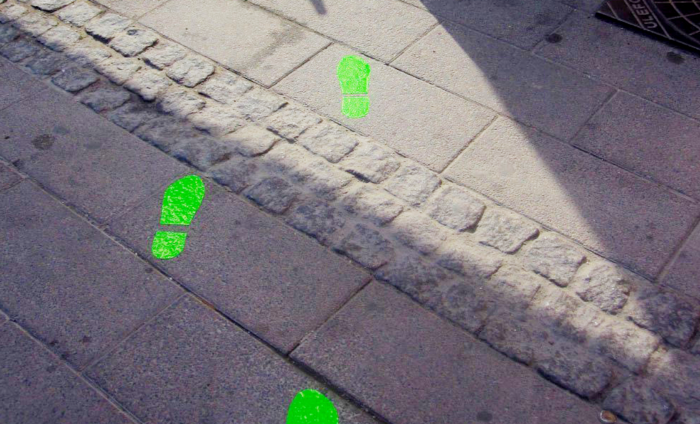Whether it be the layout of your living room furniture, the distance between your makeshift home desk and the kitchen, or your neighborhood walking route, these past few months have provided lots of opportunities to become familiar with our immediate surroundings. But do we notice how much our surroundings, even the seemingly mundane features, are shaping us?
This moment, one where we might be limited to exploring our own homes and communities, provides a space for us to recognize the ways that our built environments influence behavior. And COVID-19, in particular, highlights how certain designs can promote prosocial behavior for the benefit of all.
Take your local supermarket, for example. The lines on the ground placed six feet apart prompt patrons to practice physical distancing via a relatively inexpensive and unobtrusive intervention.

Like COVID-19, our current environmental dilemmas require individuals to do their part to make collective change. And similarly, there are ways in which we can design our built environments to nudge people towards pro-environmental behaviors. Applying one of our behavior levers — choice architecture — is just one way of doing so.
Laying the Foundation: What is Choice Architecture?
Choice architecture is a means of designing the decision-making context through the way we prompt, structure, or frame choices. Through seemingly subtle cues in our environment, it harnesses existing cognitive biases, routines, and habits so that being sustainable becomes our default.
As we all know, attention is a limited resource more than ever these days. Faced with an infinite number of daily choices and a diminished attentional capacity, it becomes difficult to devote energy towards our environmental goals. By directing attention to the desired behavior (or away from undesired behavior), making the desired behavior the default, simplifying decisions and messages, or by providing timely prompts, this tool can assist us in making healthier, more sustainable decisions.
The good news is that there are many examples of this already at-work in our built environment. And these often focus on green behaviors like biking, walking, or eating plant-rich foods, which can have numerous benefits to human health in addition to the planet.
So, let’s take a look at a couple of opportunities to use choice architecture to help advance both sustainability and the well-being of the people who interact with it.
Building the Evidence

Simple Steps to Reduce Urban Litter
As lockdowns ease and more people make their way outside for physically-distanced gatherings, we are seeing documented spikes in littering. A timely example of a way to combat this undesirable behavior comes to us from on the ground, quite literally, in Copenhagen. Behavioral scientists placed green footprint stickers leading to trash cans in order to make the path to the receptacles salient to pedestrians. Despite its simplicity, this intervention reduced littering by an impressive 46 percent.

Shorter Blocks, Better Walks
Unfortunately, the pandemic has limited some of our public transit options, making walkable spaces even more important. On top of this, choosing walking over driving can significantly reduce our environmental footprints and improve our mental health. Research shows that, on average, designing for shorter city blocks with high intersection-density (as opposed to “dendritic” or winding streets) can increase walking behavior. Just one example of this design comes from Portland, Oregon. There, you can find the “200 ft. block,” which helps ease pedestrian wayfinding, trip planning, and makes walking more visually interesting.
Lowering Water Use With Labels
Water scarcity affects every continent. In order to combat this issue, water must be treated as a limited resource. But providing people with general information about the consequences of heavy water use is generally not effective. As an alternative solution, researchers in Perth, Australia, used a simple strategy to change behavior: timely reminders. They attached small labels on showers and appliances in households to target key moments of decision-making. The result? Water use fell by 23 percent. With our improved handwashing habits these days, we might benefit from a few helpful nudges to turn off the faucet while scrubbing.
Using the Blueprint
Through these examples, we see that small (and sometimes imperceptible) changes to our built environment can make observable differences in human behavior. Rather than overwhelming our already strained attention spans with more information, policies, and options, choice architecture can simplify and improve our decision-making for the good of the community.
Like all behavioral interventions, choice architecture must maintain a focus on human experiences, individual rights, and the broader social context for decision-making in order to be effective and ethical. The development of these solutions, big and small, should incorporate the needs and interests of those at the heart of change.
The pandemic provides a unique opportunity to reimagine the form and function of constructed environments. From physical distancing to water use, even simple interventions of choice architecture hold a world of potential for both people and the planet.
So, while we are all at home, let’s try to imagine the ways we might be able to design our immediate environments to ease sustainable action. Could a post-it note help prompt you to turn off your computer monitor at the end of the workday? Could placing your fruits and vegetables in the front of the fridge be the key to improving your plant-rich eating habits? Or could simply serving your food on smaller plates help decrease your household food waste? Try it out. During this tough time, it is nice to have these helpful cues to be a bit more green.
Learn more about Rare’s Center for Behavior and the Environment at behavior.rare.org.